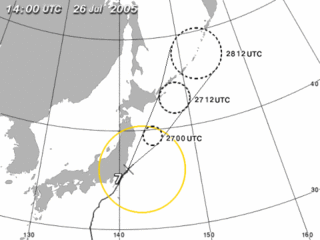
Famous last words but it seems the typhoon missed us. I was expecting furiously banging amado and sheets of rain skeltering across the roof tiles, but it seems it was a very damp squib. Not much more than a bad downpour in England.
Don't think they are all going to be this gentle so I'll take this opportunity for some complacent rambling.
The name "typhoon" has an extraordinary history. I had thought it was a straight borrowing from the East into English, as the Japanese call these storms "taifu" and the Cantonese Chinese call them "Taaîfung". However, it seems the English word has some of its roots in the ancient Greek word tuphōn, used both as the name of the father of the winds and a common noun meaning “whirlwind, storm". It was borrowed into Arabic as "Tūfān" in the middle ages and passed into India via Arabic-speaking Muslim invaders. It is believed the first English usage, recorded in 1588, came to us through this Indian route and originally specifically referred to a severe storm in India. It seems the Cantonese word Taaîfung, literally meaning great wind, may have occurred quite independently of this lineage. It was borrowed by the Japanese and this separate far Asian usage then reinforced the existing English term and coalesced with it. Shelley's Prometheus Unbound (1819) was the first to use the modern spelling. (Etymology from the American Heritage Dictionary, Houghton Mifflin)
The naming of the individual storms is also interesting. Until 2000, typhoons were named according the American practice of using proper names for their hurricanes (which are the same thing but east of 180 degrees longitude). The Asian side of the Pacific has since switched to a new and gloriously complicated naming procedure, which draws on a list of names submitted by 14 countries in the region. For instance, the name of today's typhoon, Banyan, was submitted by Hong Kong and is a type of tree.
It seems some of the member nations have got a feel for what they are doing. The Philippines, for instance, opts for words meaning "sharp", "powerful" and "swift", although their choice of "Typhoon Downspout" ("Imbudo), which actually killed quite a few people in 2003, seemed a bit eccentric.
"Typhoon Downspout"

North Korea, as usual, is way offbeat. Typhoon Pongsona which killed dozens on Guam in 2002, was named after a "beautiful flower specially loved by Korean women from ancient time for its fairy shyness and tender feeling" while Typhoon Podul, which generated winds of nearly 300 kph, referred to a tree under which "people rest and enjoy chatting." I think they just have a black sense of humour. Only the Macanese, however, seem to have grasped what a great marketing opportunity this storm naming is. "Typhoon Bebinca", which clattered into the Philipinnes in 2000, was named after "a Macanese milk pudding served in the Portuguese restaurants of Macau".
The Japanese, while contributing names to this system, refuse to use it themselves, instead opting for a simple numbering system. How wonderfully British of them! Just what what John Bull would have done if the French were sending over "Hurricane Foie Gras" and the Germans "Hurricane Edelweiss".
4 comments:
Good research and most interesting....what number was banyan?
7! But I don't remember other 6...
Perhaps they didn't come to Japan
Good commenting Mum! I mean rockstar. I feel less lonely now.
Must remember to do my homework each day in future!
Post a Comment